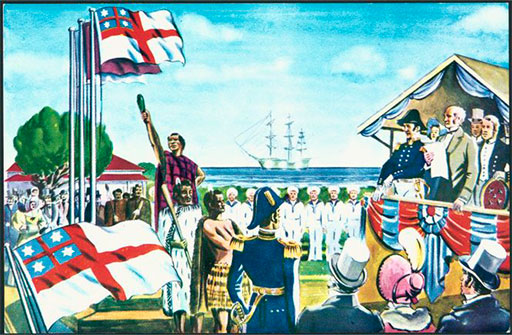In New Zealand the term bicultural refers to Māori and non-Māori. The Treaty of Waitangi put in place a partnership between Māori and the British Crown.
There are many different interpretations of what biculturalism should look like. An important part of biculturalism is the acknowledgement that Māori are tangata whenua (the people of the land) and have a special relationship with the land. As Treaty partners, Māori should have equal rights, protection and status.

Moving towards a bicultural New Zealand
Since the 1970s, the New Zealand Government has moved to create a society that is more bicultural in practice. Some important aspects of biculturalism in New Zealand:
- The place of the Treaty of Waitangi in our laws.
- Te Reo Māori – the place of the Māori language as one of the official languages of New Zealand.
- Preservation and celebration of Tikanga Māori (the right practice) as having equal status and correctness as non–Māori customary practices.
- Land ownership – taking into account historical events and present populations and residency.
- Equal opportunities for Māori to succeed economically, educationally, and in the justice system.
Read more: Janine Hayward. Biculturalism, Te Ara - the Encyclopedia of New Zealand.
Biculturalism and New Zealand law
These are some of the important documents or laws which affected how the Treaty was implemented:
1840: Treaty of Waitangi written and signed by around 500 rangatira and representatives of the British Crown.
1862: Native Lands Act and 1865 Native Land Act – the Māori Land Courts were set up and legal procedures for changing ownership of land were implemented.
1877: Chief Justice James Prendergast ruled that the Treaty was a ‘simple nullity’ having been signed by ‘primitive barbarians’.
1938: Prendergast’s ruling was overturned. Now it was believed the Treaty was valid in terms of transfer of sovereignty but was not binding on the crown.
1960: Waitangi Day Act – February the 6th would be known as Waitangi Day but not a public holiday.
1974: Waitangi Day made a national public holiday. It was known as New Zealand Day, but changed back to Waitangi Day in 1976.
1975: Treaty of Waitangi Act – The Waitangi Tribunal was established to hear Māori grievances against the crown concerning breaches of the Treaty.
1985: Treaty of Waitangi Amendment Act – Tribunal has exclusive authority to determine meaning and effect of the Treaty as it is embodied in both the English and Māori texts.
1987: Māori Language Act – Te Reo Māori was declared an official language of New Zealand and recognised as a taonga under the Treaty. See Te Wiki o te Reo Māori / Māori Language Week.
1998: Ngai Tāhu Deed of Settlement agreed on for the Ngāi Tahu claim and an apology made for not honouring Treaty obligations.
2004: New Zealand Foreshore and Seabed Act.
2010: New Zealand Foreshore and Seabed Act was repealed (removed).

Biculturalism resources
Waitangi Tribunal
A background to the Waitangi Tribunal. A lot of historical information available on this site. The language can get tricky, grab an adult if you need some help.
Te Ao o Te Māori: The World of the Māori, Ruth Naumann
Suitable for 8 to 14–year–olds.
Te Mana O Te Tiriti: The Living Treaty, Ruth Naumann
Excellent guide to the Treaty through history. Suitable for 8 to 14–year–olds.
Two Peoples, One Land, Elsie Locke
Aimed at younger readers. Suitable for 7 to 12–year–olds.
Biculturalism at Christchurch City Libraries
Te Whata Raki
Explore our online world with your guide, Whetu Marama. Learn some traditional stories, told through waiata, pictures and other web resources and then try the quiz. Te Whata Raki is now entirely bilingual and available as an app for Android and iPad 2 (and above).
Preschoolers‘ events and programmes – Ngā hōtaka kōhungahunga
Wā Pēpi / Babytimes and Wā Kōrero / Storytimes. These preschool sessions are held weekly during term times. Sessions have songs and rhymes in English and Te Reo Māori. Sessions are held in Te Reo during Te Wiki O Te Reo Māori / Māori Language Week in some of the libraries.
Matariki
Christchurch City Libraries has a full programme of events every year to celebrate Matariki, including crafts, storytimes and sessions for early childhood centres.

